
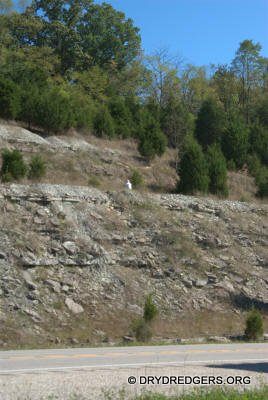



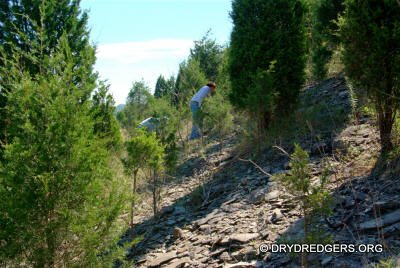
Photos by Bill Heimbrock
It was the first full day of autumn in Northern Kentucky. The Dry Dredgers enjoyed temperatures in the high 70s and low 80s with plenty of sun but a nice breeze. Bob Bross and Ron Fine chose some decent road cuts along a scenic byway running east from Newport KY. The chosen sites exposed the Kope and Point Pleasant formations and hadlots of good-condition Late Ordovician Period fossils that were about 450 million years old. The road cuts themselves have been there and weathering for at least 20 years. That's not a long time compared to how long those marine invertebrate fossils were buried, waiting for us to unearth them.
We fossil hunted for more than 3 and a half hours. That's a tribute to how much everyone was enjoying the weather and the fossils they were finding. Here are some beautiful pictures of us enjoying the fossil sites Bob and Ron picked out for us.
Fossils Found That Day
Four sites were visited that day.I'll try to indicate on which site each of these fossils were found.
Trilobites
Trilobites are always found in this road. Here's a photo
contributed by Marianne Shelton of her best find from site #4. It's a prone
Flexicalymene sp. and
quite nice! 
Next an enrolled Flexicalymene sp.
found on site #1 within 15 minutes of arrival. We were off to a great start.
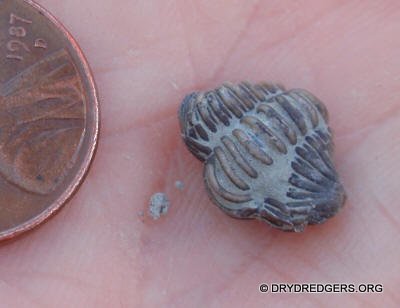
Most of the Flexicalymene sp. parts we found were molted
parts. Here's a glabella of another Flexicalymene sp.

And here's a very artistic and educational nautiloid
cephalopod filled with silt and Flexicalymene
trilobite parts!
The most rare trilobite on these outcrops to find complete but also the most common trilobite to find in parts is Cryptolithus sp, more commonly known as the "Lace Collar" trilobite. Here are some of the many lace collars we saw. (next 4 photos)
The cephalon (head) of the "Lace Collar" trilobite is much
harder to find, but a few were found. (next 2 pics)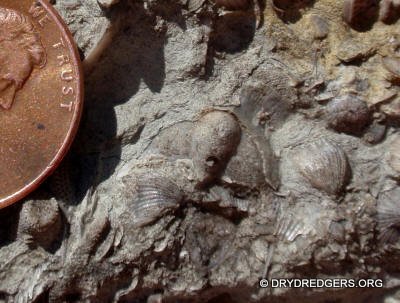

The next most abundant trilobite fragment was that of the
Isotelus sp.
Here's a fragment of either the head or the tail. This was a large trilobite
when it was alive.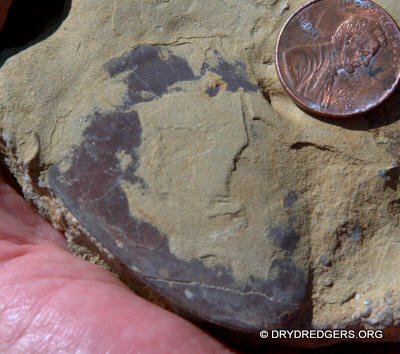
Much less common were fragments of the tiny spiney trilobites
Meadowtownella crosotus and Acidaspis
cincinnatiensis. These next 2 photos show a couple of fragments,
but I can't tell which species that are.
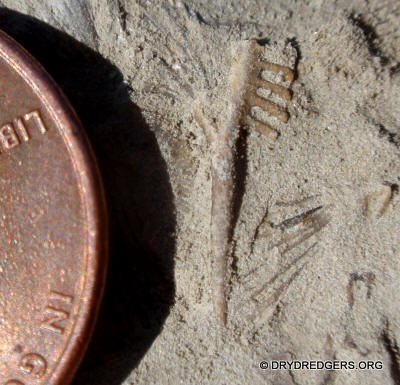
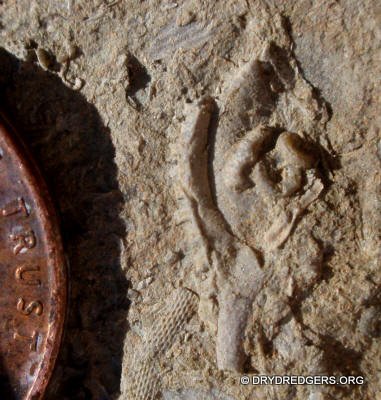
Nautiloid Cephalopods
Here's one of the nicest cephalopods found that day. This is
is probably part of a Westonoceras ortoni (Meek 1872).
These are not common, so it's a nice find! (next 2 pics)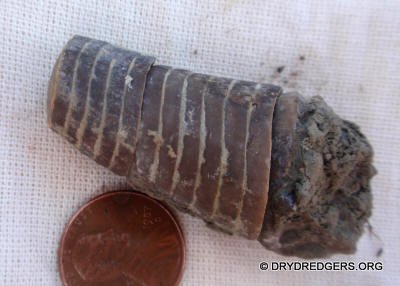
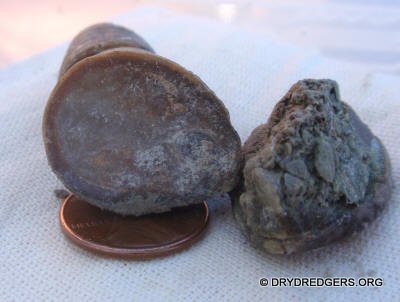
These next three fossils are interesting because they both
show the Siphuncle very clearly. This is a tube running down the interior of the
of the shell. Very cool.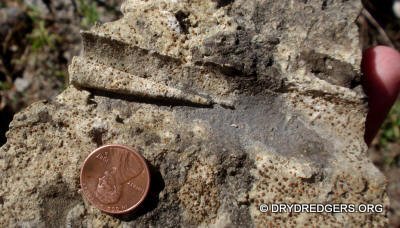
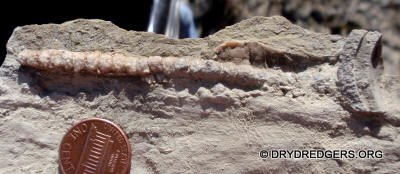

We also found a lot of internal molds of the orthocone
chambers of the cephalopods. (next 6 pics)
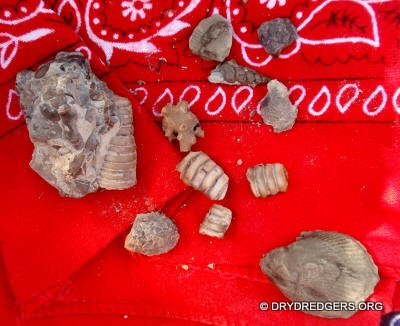
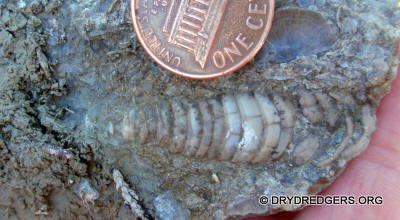
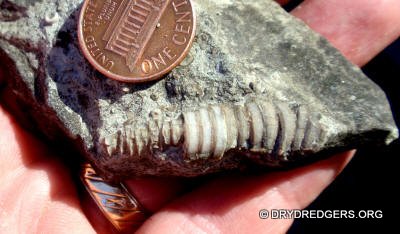
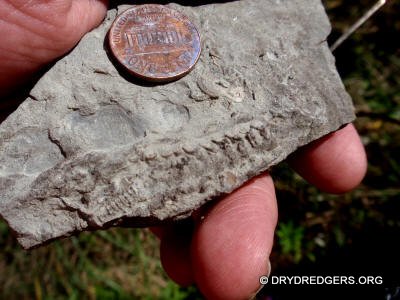
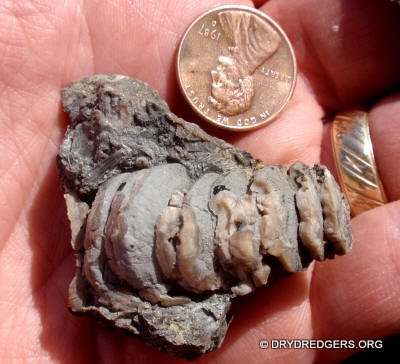
Here's a slab with lots of brachiopods and a hollowed out
nautilod cephalopod. Notice the calcite crystals inside the cephalopod.

Crinoids
Some great crinoids were found on the first site we visited.
The best find was this slab with multiple calyxes. These were
both
Ectenocrinus simplex. (next 3 pics)
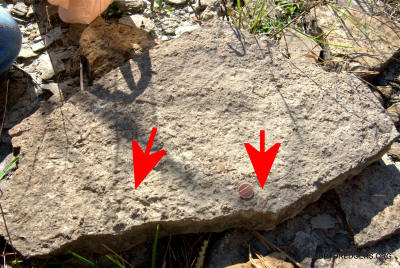

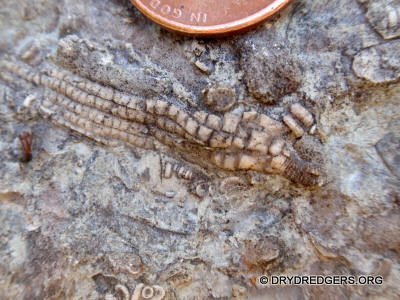
Other slabs such as the one in the next 2 photos had lots of
articulated stems and looked like they might have calyxes, but they didn't.
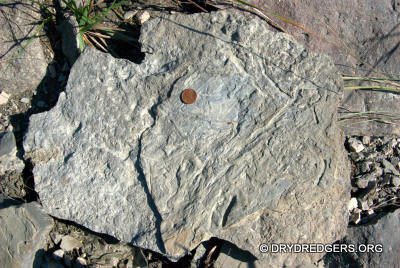
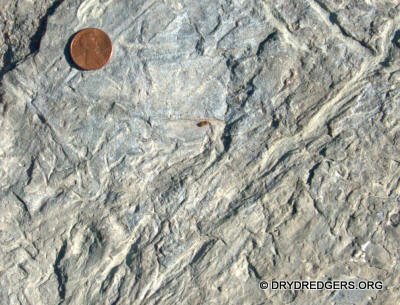
Some rocks were loaded with crinoid stems. (next 2 pics).

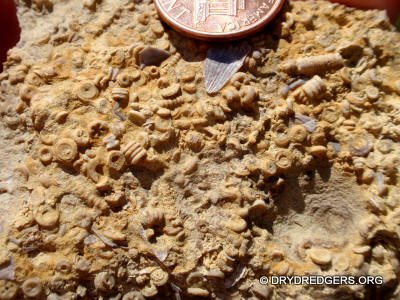

Brachiopods
Both the first and second site had a layer in the Southgate
member of the Kope Formation with large quantities of an unusual brachiopod.
Shown in the next 2 photos below are Strophomena millionensis.
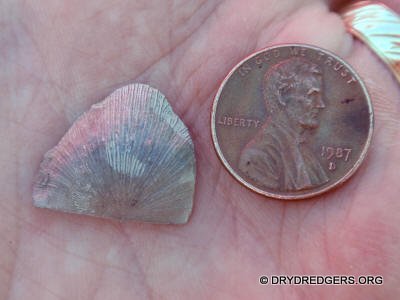

But much more abundant were very tiny brachiopods everywhere -
Zygospira modesta.
(next 3 pics)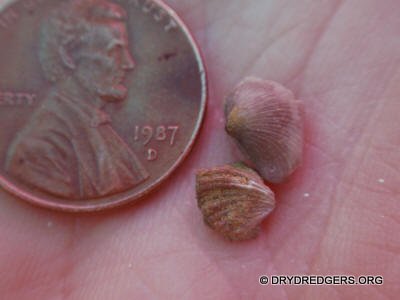
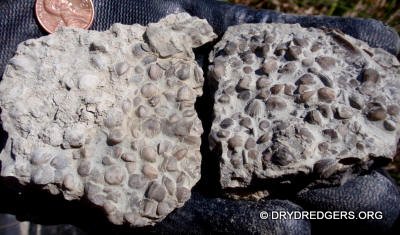
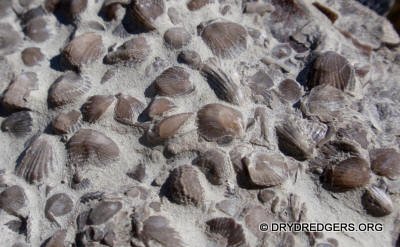

Another brachiopod found in huge quantities was
Sowerbyella rugosa. (next 3
pics)
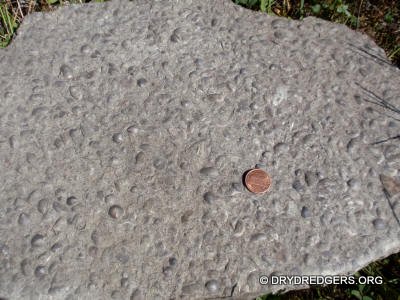
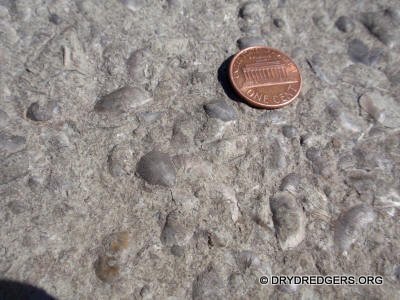
In the Kope formation, it's uncommon to find the large
brachiopod Rafinesquina sp.
Yet we found them on site#2. The slab in the next 2 photos proves their
existence alongside the lace collars of Cryptolithus sp.
trilobites. The top side in the first photo has the brachiopods and the
side of the slab in the second photo has the trilobite lace collar.
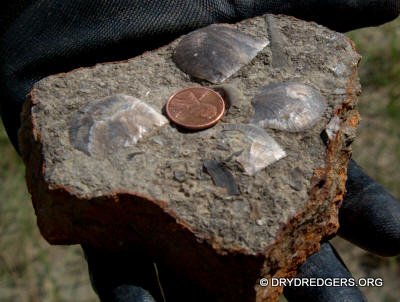
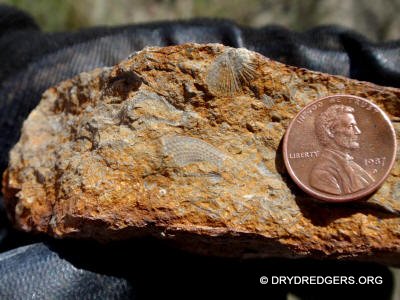
Some slabs had lots of badly broken fragments of brachiopods
making colorful artwork.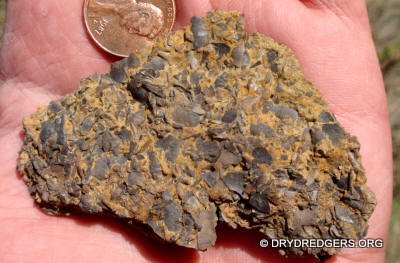
Graptolites
We found a layer of 3-dimensional graptolites on nodules and
rock surfaces. These are spectacular specimens, preserved in pyrite and
phosphate. Awesome finds! (next 2 pics).
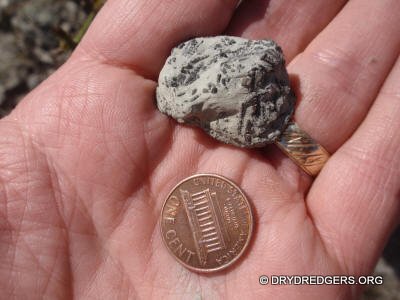
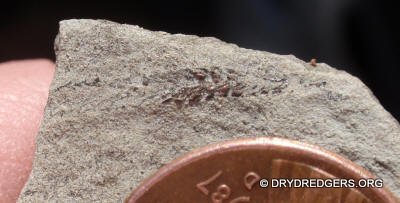
Normally, graptolites are found preserved as simply black
marks on the surface of slabs. Here's a more common slab of them we found that
day. It's still interesting to the eye, don't you think?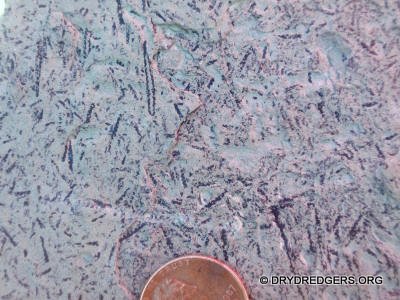
Bryozoans
Bryozoans are probably the most common and ubiquitous fossil
in our late Ordovician Cincinnatian rocks. And yet we seem to always find
interesting specimens. The most interesting bryozoan was this next specimen. I
think it was encrusting something, but I'm not sure what. It's shaped as if it
has encrusted a Cystoid, which is a rare type of Echinoderm. Beyond that, I'm
thinking there is more bryozoan underneath it. 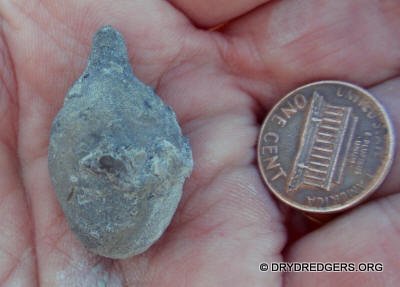
Many of the bryozoans were growing on something that was not preserved. Here are a few of those. (next 2 pics)
This next bryozoan has high monticules - those bumps on the
surface. It looks a bit like Constellaria sp. but is
more likely to be Parvohallopora sp..
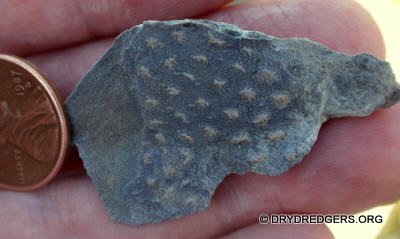
Gastropods
Here's a beautiful gastropod. It's Cyrtolites
carinatus. It's actually classified as a Monoplacophoran.
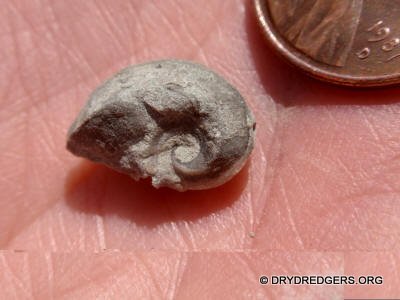
Here's another beautiful gastropod found on the first site.
It's probably a Hormotoma terebriformis.
Here's another nice snail that was partially burried. I think
it's Liospira micula.
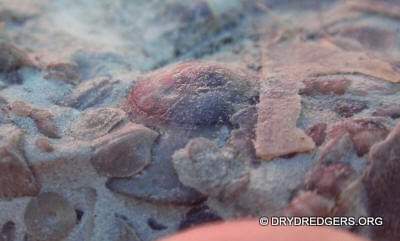
These slabs show how common these gastropods are in some
layers. They are loaded with snails!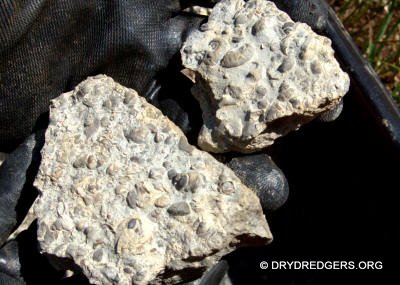
Ichnofossils (Trace Fossils)
Here's the most interesting trace fossil we found. I can't
tell what made this interesting shape, because what is left is only the silt
formed into a shape that resembles a cluster of worm tubes of Cornulitids. The
best hypothesis I've heard so far is that it's one or more crinoid stems that
were rolling around in a burrow left by some other animal. (next 3 pics)

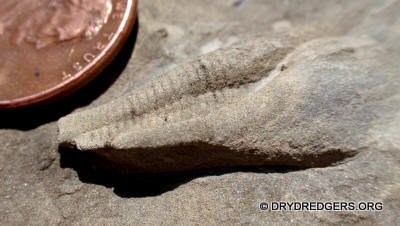
Oddly, we found a lot of trace fossil tracks that were going
around in circles. This first one was probably made by a trilobite, based on the
shape of the burrow. 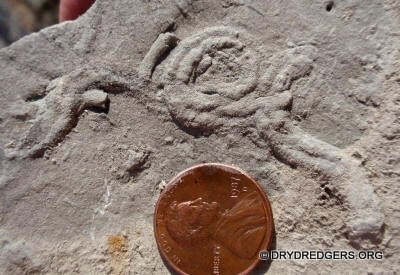
A couple more circular traces however, had no evidence of what
kind of animal made them.

Here's a circular or disk-shaped shale object that has a
burrow in the center that is filled with pyrite or iron colored shale.
Originally, it was a nodule of the type very common to these specific layers.

And the next trace fossil has an interesting nickname - "Turkey Tracks." They are not made by Turkeys, it just resembles them a bit when you have a large number of these tracks. The actual cause of the tracks is still being debated.
Here's another very interesting trace fossil shown in the next
two photos. The member who found it conjectured that it might be a Conularia.
But it's made out of the same shale as the surrounding slab. Perhaps it's the
impression of the surface of a clam. Or perhaps it's a crinoid stem rolling
around on the sea floor. Purely speculation.

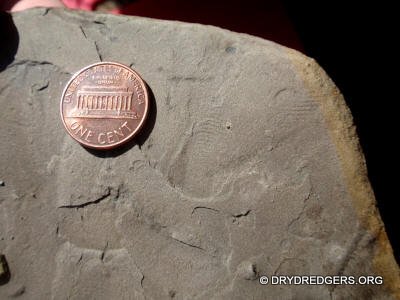
These next 2 photos show a burrow that has scratch marks in
the bottom. Remember, you are looking at the silt that has filled in the burrow.
So it's a negative impression of the burrow.

This interesting slab has marks all over it. The slab is
heavily worn by weather. I can't begin to guess as to what made these marks.
What do you think it was?
Bivalves (clams)
Here's a really nice internal mold of Ambonychia
sp. showing both sides in the first and second photos.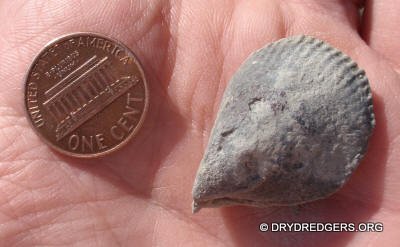
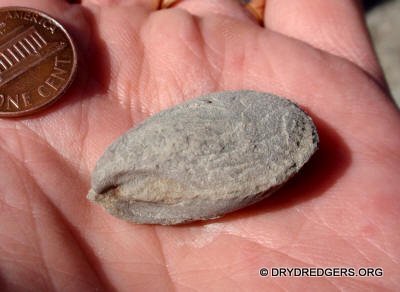
This next Ambonychia sp. is
preserved in a nice brown calcite. 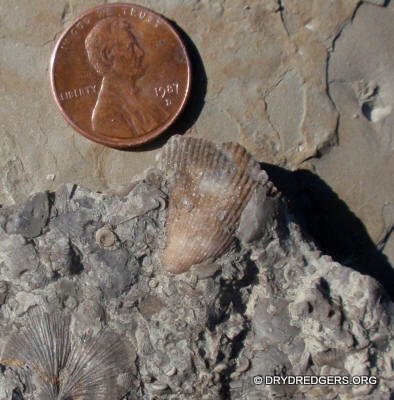
But we also saw impressions of clams on shale surface, like
the slab below. These look like Ambonychia sp. also.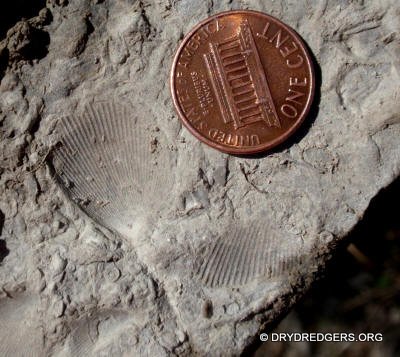
And finally, to end with a "breath of fresh air." It's golden
rod - loved by all - including this monarch butterfly stopping by on its
migratory journey. 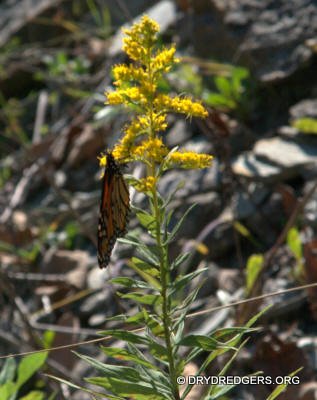
That's all for this trip. Hope you enjoyed it.
Now lets see the September 2017 field trip to Southeastern Indiana.
See previous trips down this scenic byway in northern Kentucky
May 2016
April 2014
October 2010
October 2008
Back to the Field Trip Index Page
Return to Dry Dredgers Home Page
The Dry Dredgers and individual contributors reserve the rights
to all information, images, and content presented here. Permission to reproduce
in any fashion, must be requested in writing to
admin@drydredgers.org.
www.drydredgers.org
is designed and maintained by Bill Heimbrock.